Human Resource Management Report: Say It With Chocolate, HRM Analysis
VerifiedAdded on 2021/01/02
|22
|6198
|195
Report
AI Summary
This report provides a comprehensive overview of Human Resource Management (HRM) practices within the context of "Say it with chocolate," a food producing company. It explores the purpose, scope, and functions of HRM, including resourcing and workforce planning, examining the nature and scope of HRM, and the application of best-fit versus best-practice approaches. The report details recruitment and selection processes, analyzing strengths and weaknesses of internal and external recruitment methods. It also evaluates the benefits and effectiveness of various HRM practices, including learning and development, employee relations, and compensation. Furthermore, the report addresses the importance of employee relations in HRM decision-making and the impact of employment legislation. The report also covers workforce planning, including internal and external labor markets and labor market trends, and concludes with an application of HRM practices in a work-related context.
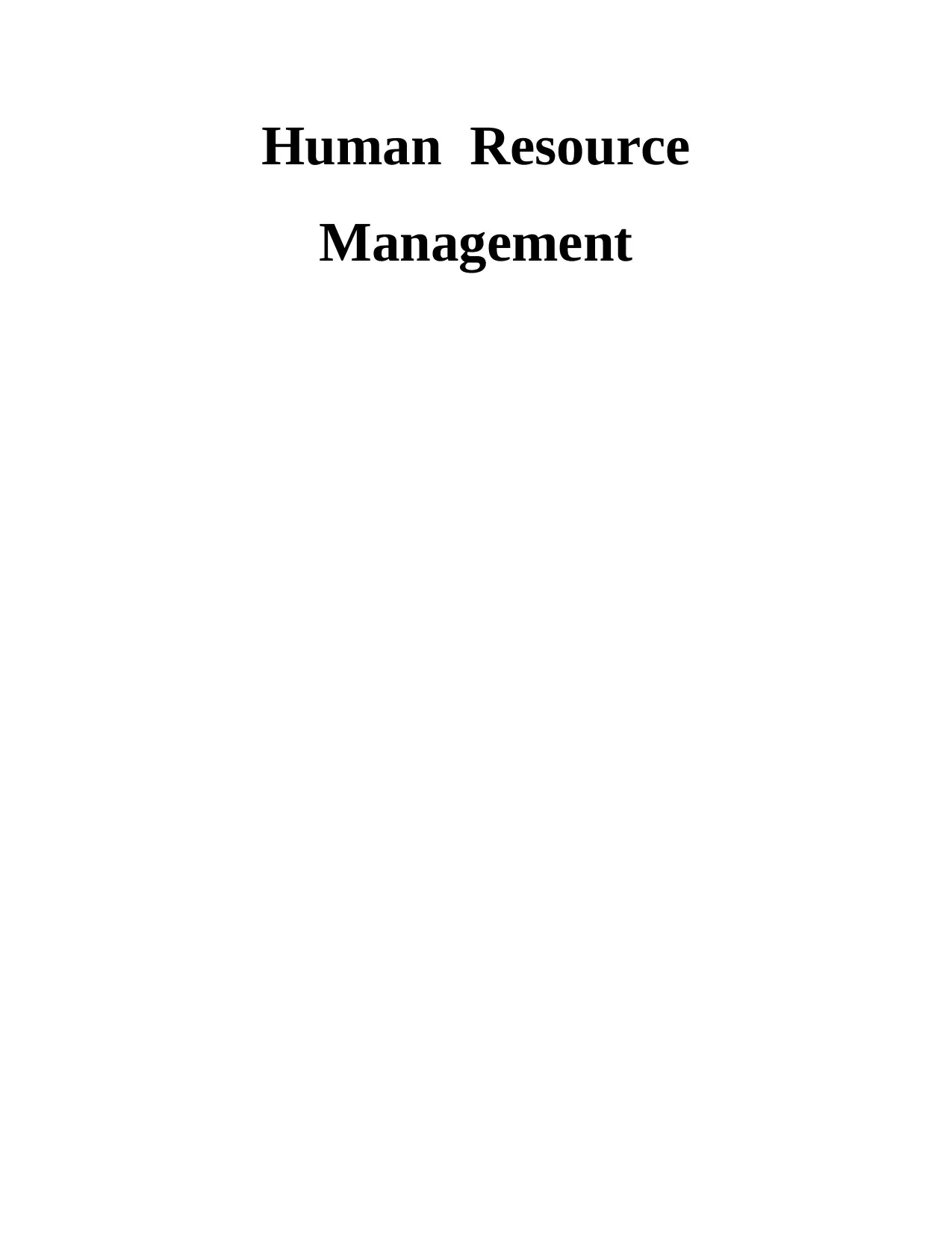
Human Resource
Management
Management
Paraphrase This Document
Need a fresh take? Get an instant paraphrase of this document with our AI Paraphraser
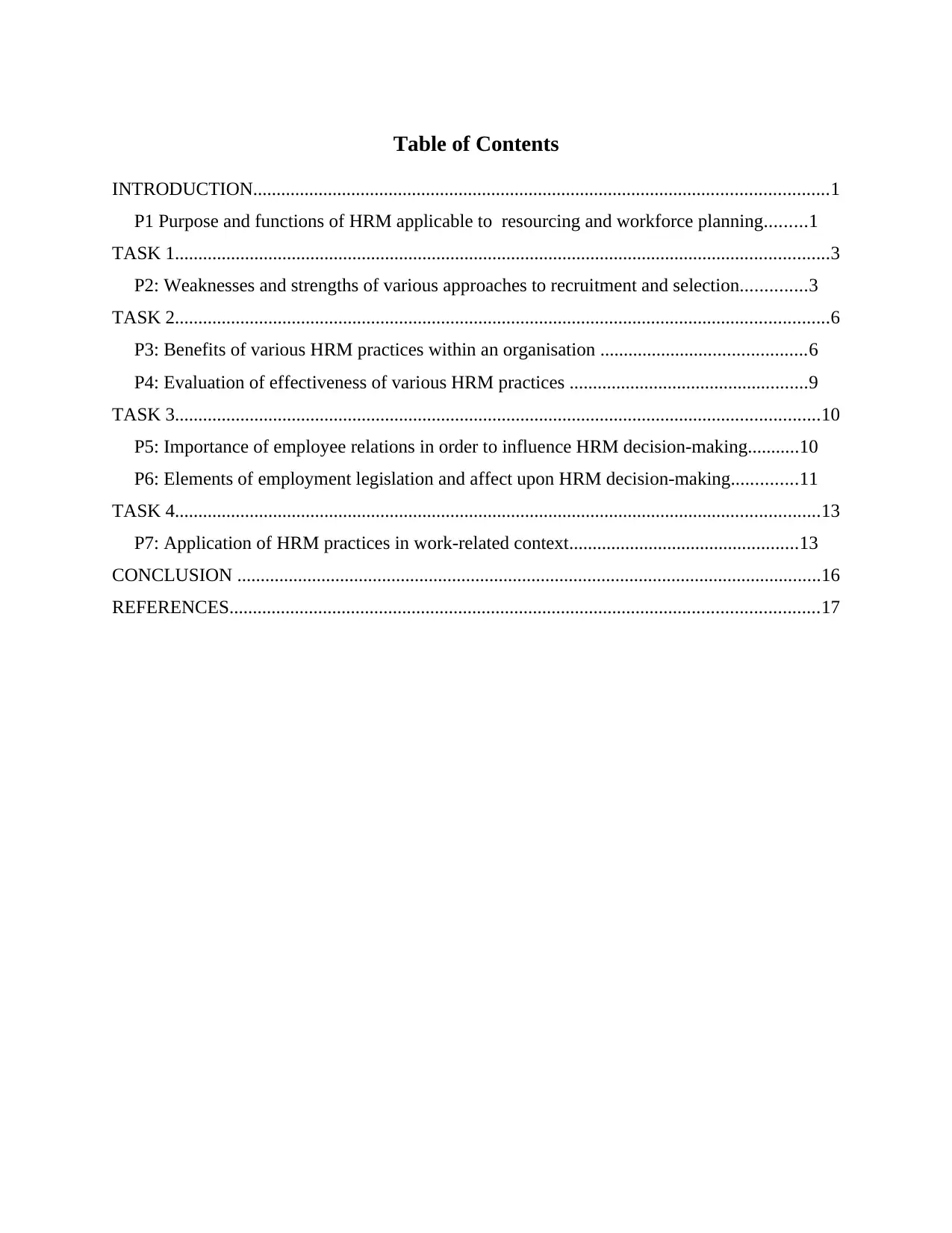
Table of Contents
INTRODUCTION...........................................................................................................................1
P1 Purpose and functions of HRM applicable to resourcing and workforce planning.........1
TASK 1............................................................................................................................................3
P2: Weaknesses and strengths of various approaches to recruitment and selection..............3
TASK 2............................................................................................................................................6
P3: Benefits of various HRM practices within an organisation ............................................6
P4: Evaluation of effectiveness of various HRM practices ...................................................9
TASK 3..........................................................................................................................................10
P5: Importance of employee relations in order to influence HRM decision-making...........10
P6: Elements of employment legislation and affect upon HRM decision-making..............11
TASK 4..........................................................................................................................................13
P7: Application of HRM practices in work-related context.................................................13
CONCLUSION .............................................................................................................................16
REFERENCES..............................................................................................................................17
INTRODUCTION...........................................................................................................................1
P1 Purpose and functions of HRM applicable to resourcing and workforce planning.........1
TASK 1............................................................................................................................................3
P2: Weaknesses and strengths of various approaches to recruitment and selection..............3
TASK 2............................................................................................................................................6
P3: Benefits of various HRM practices within an organisation ............................................6
P4: Evaluation of effectiveness of various HRM practices ...................................................9
TASK 3..........................................................................................................................................10
P5: Importance of employee relations in order to influence HRM decision-making...........10
P6: Elements of employment legislation and affect upon HRM decision-making..............11
TASK 4..........................................................................................................................................13
P7: Application of HRM practices in work-related context.................................................13
CONCLUSION .............................................................................................................................16
REFERENCES..............................................................................................................................17

⊘ This is a preview!⊘
Do you want full access?
Subscribe today to unlock all pages.

Trusted by 1+ million students worldwide
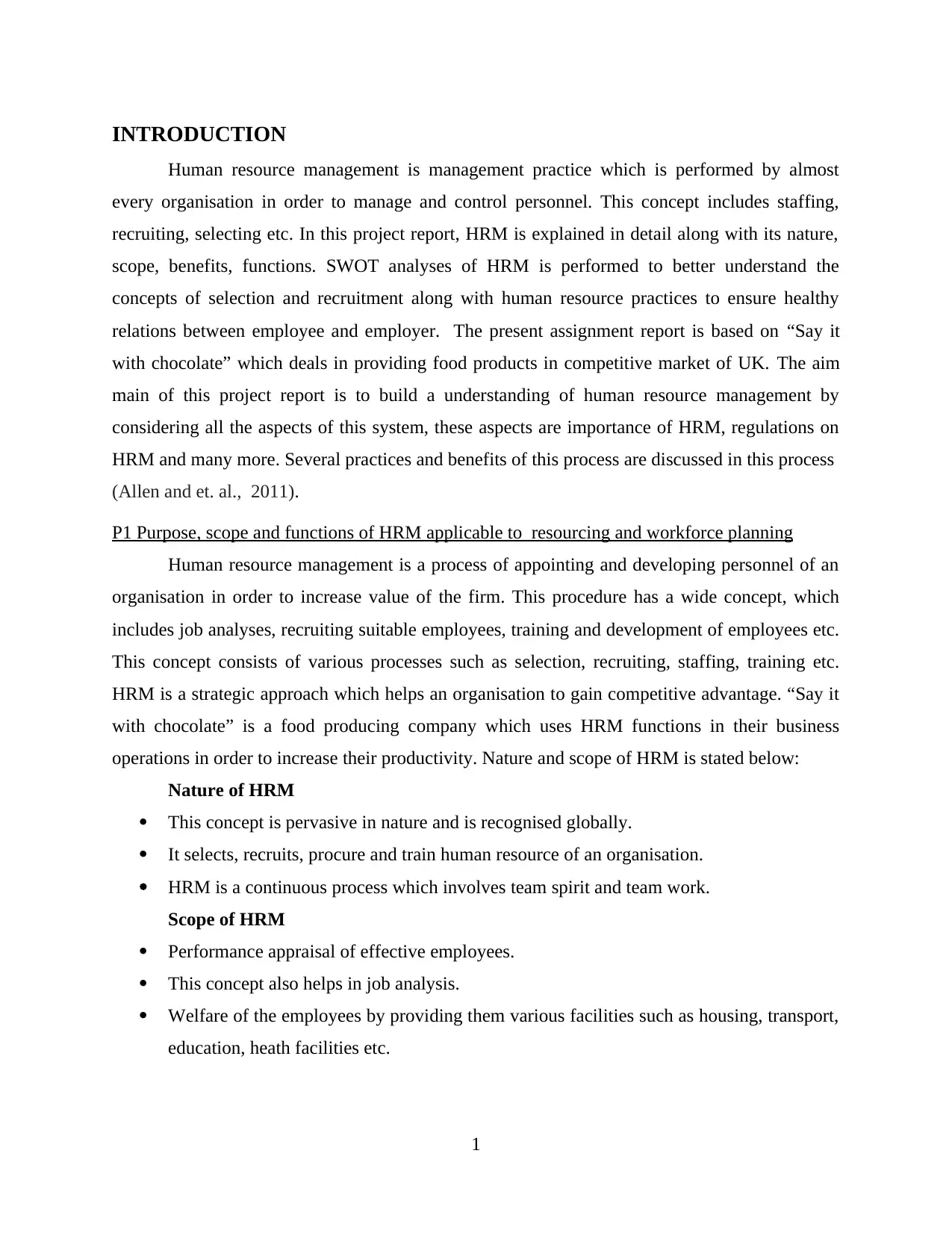
INTRODUCTION
Human resource management is management practice which is performed by almost
every organisation in order to manage and control personnel. This concept includes staffing,
recruiting, selecting etc. In this project report, HRM is explained in detail along with its nature,
scope, benefits, functions. SWOT analyses of HRM is performed to better understand the
concepts of selection and recruitment along with human resource practices to ensure healthy
relations between employee and employer. The present assignment report is based on “Say it
with chocolate” which deals in providing food products in competitive market of UK. The aim
main of this project report is to build a understanding of human resource management by
considering all the aspects of this system, these aspects are importance of HRM, regulations on
HRM and many more. Several practices and benefits of this process are discussed in this process
(Allen and et. al., 2011).
P1 Purpose, scope and functions of HRM applicable to resourcing and workforce planning
Human resource management is a process of appointing and developing personnel of an
organisation in order to increase value of the firm. This procedure has a wide concept, which
includes job analyses, recruiting suitable employees, training and development of employees etc.
This concept consists of various processes such as selection, recruiting, staffing, training etc.
HRM is a strategic approach which helps an organisation to gain competitive advantage. “Say it
with chocolate” is a food producing company which uses HRM functions in their business
operations in order to increase their productivity. Nature and scope of HRM is stated below:
Nature of HRM
This concept is pervasive in nature and is recognised globally.
It selects, recruits, procure and train human resource of an organisation.
HRM is a continuous process which involves team spirit and team work.
Scope of HRM
Performance appraisal of effective employees.
This concept also helps in job analysis.
Welfare of the employees by providing them various facilities such as housing, transport,
education, heath facilities etc.
1
Human resource management is management practice which is performed by almost
every organisation in order to manage and control personnel. This concept includes staffing,
recruiting, selecting etc. In this project report, HRM is explained in detail along with its nature,
scope, benefits, functions. SWOT analyses of HRM is performed to better understand the
concepts of selection and recruitment along with human resource practices to ensure healthy
relations between employee and employer. The present assignment report is based on “Say it
with chocolate” which deals in providing food products in competitive market of UK. The aim
main of this project report is to build a understanding of human resource management by
considering all the aspects of this system, these aspects are importance of HRM, regulations on
HRM and many more. Several practices and benefits of this process are discussed in this process
(Allen and et. al., 2011).
P1 Purpose, scope and functions of HRM applicable to resourcing and workforce planning
Human resource management is a process of appointing and developing personnel of an
organisation in order to increase value of the firm. This procedure has a wide concept, which
includes job analyses, recruiting suitable employees, training and development of employees etc.
This concept consists of various processes such as selection, recruiting, staffing, training etc.
HRM is a strategic approach which helps an organisation to gain competitive advantage. “Say it
with chocolate” is a food producing company which uses HRM functions in their business
operations in order to increase their productivity. Nature and scope of HRM is stated below:
Nature of HRM
This concept is pervasive in nature and is recognised globally.
It selects, recruits, procure and train human resource of an organisation.
HRM is a continuous process which involves team spirit and team work.
Scope of HRM
Performance appraisal of effective employees.
This concept also helps in job analysis.
Welfare of the employees by providing them various facilities such as housing, transport,
education, heath facilities etc.
1
Paraphrase This Document
Need a fresh take? Get an instant paraphrase of this document with our AI Paraphraser
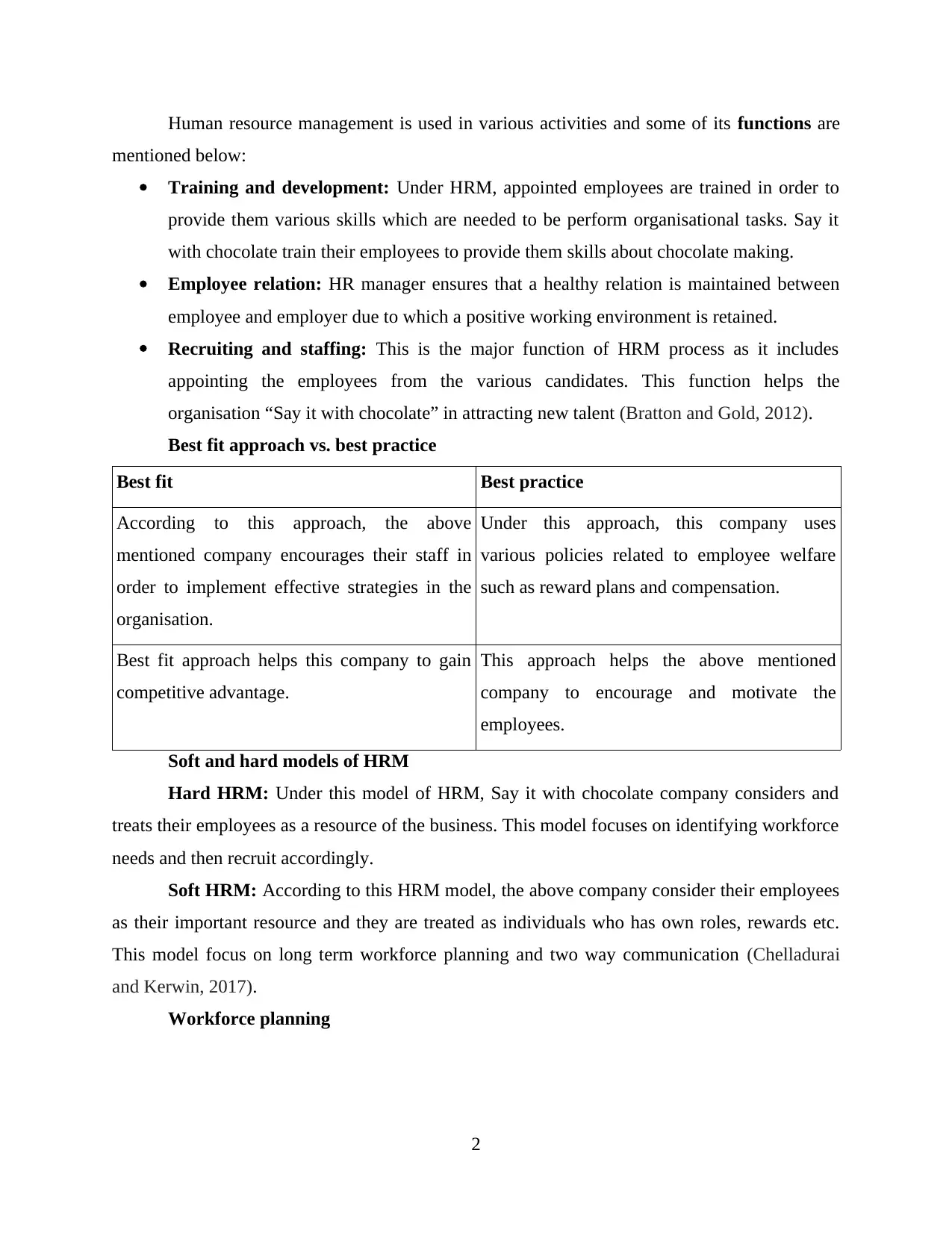
Human resource management is used in various activities and some of its functions are
mentioned below:
Training and development: Under HRM, appointed employees are trained in order to
provide them various skills which are needed to be perform organisational tasks. Say it
with chocolate train their employees to provide them skills about chocolate making.
Employee relation: HR manager ensures that a healthy relation is maintained between
employee and employer due to which a positive working environment is retained.
Recruiting and staffing: This is the major function of HRM process as it includes
appointing the employees from the various candidates. This function helps the
organisation “Say it with chocolate” in attracting new talent (Bratton and Gold, 2012).
Best fit approach vs. best practice
Best fit Best practice
According to this approach, the above
mentioned company encourages their staff in
order to implement effective strategies in the
organisation.
Under this approach, this company uses
various policies related to employee welfare
such as reward plans and compensation.
Best fit approach helps this company to gain
competitive advantage.
This approach helps the above mentioned
company to encourage and motivate the
employees.
Soft and hard models of HRM
Hard HRM: Under this model of HRM, Say it with chocolate company considers and
treats their employees as a resource of the business. This model focuses on identifying workforce
needs and then recruit accordingly.
Soft HRM: According to this HRM model, the above company consider their employees
as their important resource and they are treated as individuals who has own roles, rewards etc.
This model focus on long term workforce planning and two way communication (Chelladurai
and Kerwin, 2017).
Workforce planning
2
mentioned below:
Training and development: Under HRM, appointed employees are trained in order to
provide them various skills which are needed to be perform organisational tasks. Say it
with chocolate train their employees to provide them skills about chocolate making.
Employee relation: HR manager ensures that a healthy relation is maintained between
employee and employer due to which a positive working environment is retained.
Recruiting and staffing: This is the major function of HRM process as it includes
appointing the employees from the various candidates. This function helps the
organisation “Say it with chocolate” in attracting new talent (Bratton and Gold, 2012).
Best fit approach vs. best practice
Best fit Best practice
According to this approach, the above
mentioned company encourages their staff in
order to implement effective strategies in the
organisation.
Under this approach, this company uses
various policies related to employee welfare
such as reward plans and compensation.
Best fit approach helps this company to gain
competitive advantage.
This approach helps the above mentioned
company to encourage and motivate the
employees.
Soft and hard models of HRM
Hard HRM: Under this model of HRM, Say it with chocolate company considers and
treats their employees as a resource of the business. This model focuses on identifying workforce
needs and then recruit accordingly.
Soft HRM: According to this HRM model, the above company consider their employees
as their important resource and they are treated as individuals who has own roles, rewards etc.
This model focus on long term workforce planning and two way communication (Chelladurai
and Kerwin, 2017).
Workforce planning
2
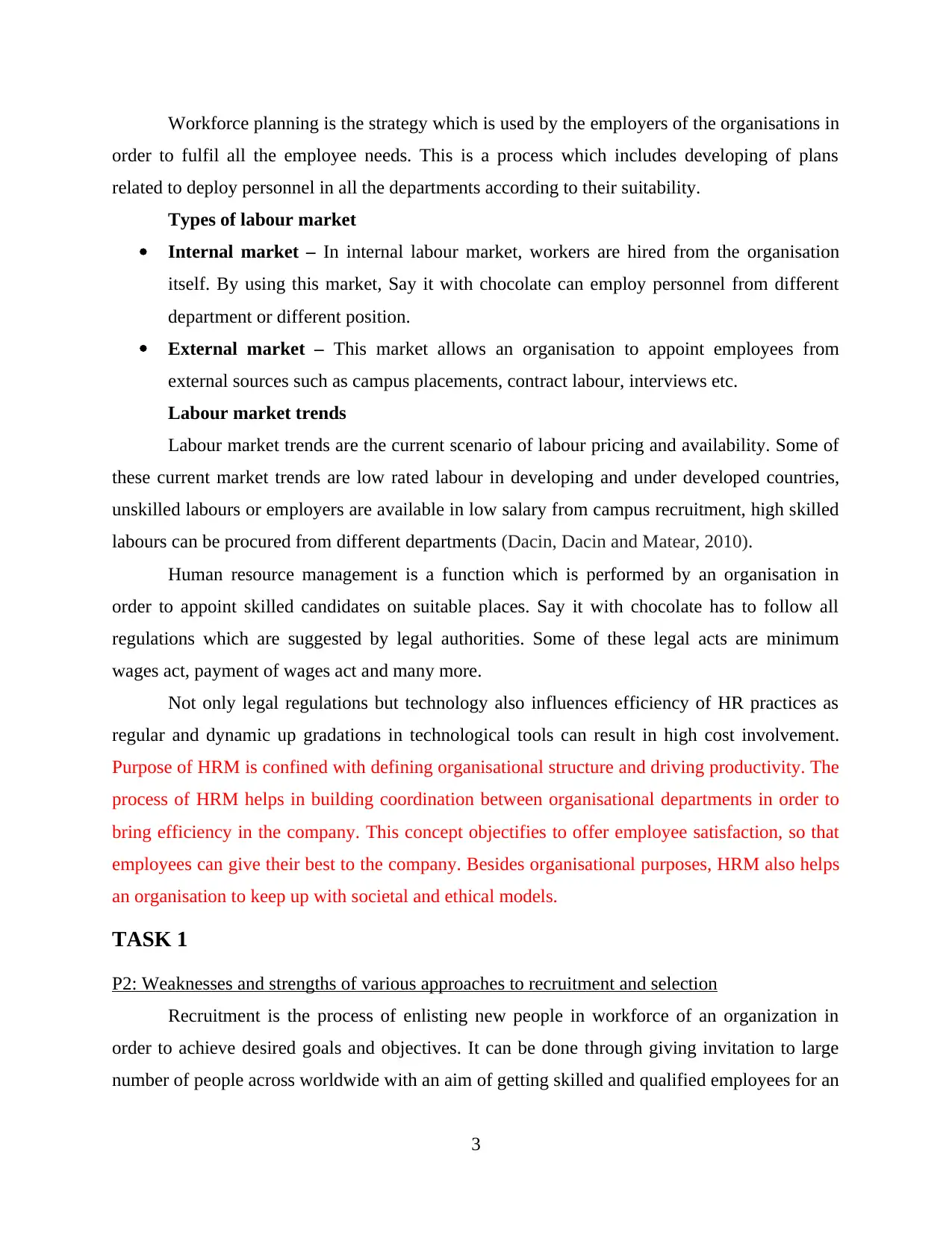
Workforce planning is the strategy which is used by the employers of the organisations in
order to fulfil all the employee needs. This is a process which includes developing of plans
related to deploy personnel in all the departments according to their suitability.
Types of labour market
Internal market – In internal labour market, workers are hired from the organisation
itself. By using this market, Say it with chocolate can employ personnel from different
department or different position.
External market – This market allows an organisation to appoint employees from
external sources such as campus placements, contract labour, interviews etc.
Labour market trends
Labour market trends are the current scenario of labour pricing and availability. Some of
these current market trends are low rated labour in developing and under developed countries,
unskilled labours or employers are available in low salary from campus recruitment, high skilled
labours can be procured from different departments (Dacin, Dacin and Matear, 2010).
Human resource management is a function which is performed by an organisation in
order to appoint skilled candidates on suitable places. Say it with chocolate has to follow all
regulations which are suggested by legal authorities. Some of these legal acts are minimum
wages act, payment of wages act and many more.
Not only legal regulations but technology also influences efficiency of HR practices as
regular and dynamic up gradations in technological tools can result in high cost involvement.
Purpose of HRM is confined with defining organisational structure and driving productivity. The
process of HRM helps in building coordination between organisational departments in order to
bring efficiency in the company. This concept objectifies to offer employee satisfaction, so that
employees can give their best to the company. Besides organisational purposes, HRM also helps
an organisation to keep up with societal and ethical models.
TASK 1
P2: Weaknesses and strengths of various approaches to recruitment and selection
Recruitment is the process of enlisting new people in workforce of an organization in
order to achieve desired goals and objectives. It can be done through giving invitation to large
number of people across worldwide with an aim of getting skilled and qualified employees for an
3
order to fulfil all the employee needs. This is a process which includes developing of plans
related to deploy personnel in all the departments according to their suitability.
Types of labour market
Internal market – In internal labour market, workers are hired from the organisation
itself. By using this market, Say it with chocolate can employ personnel from different
department or different position.
External market – This market allows an organisation to appoint employees from
external sources such as campus placements, contract labour, interviews etc.
Labour market trends
Labour market trends are the current scenario of labour pricing and availability. Some of
these current market trends are low rated labour in developing and under developed countries,
unskilled labours or employers are available in low salary from campus recruitment, high skilled
labours can be procured from different departments (Dacin, Dacin and Matear, 2010).
Human resource management is a function which is performed by an organisation in
order to appoint skilled candidates on suitable places. Say it with chocolate has to follow all
regulations which are suggested by legal authorities. Some of these legal acts are minimum
wages act, payment of wages act and many more.
Not only legal regulations but technology also influences efficiency of HR practices as
regular and dynamic up gradations in technological tools can result in high cost involvement.
Purpose of HRM is confined with defining organisational structure and driving productivity. The
process of HRM helps in building coordination between organisational departments in order to
bring efficiency in the company. This concept objectifies to offer employee satisfaction, so that
employees can give their best to the company. Besides organisational purposes, HRM also helps
an organisation to keep up with societal and ethical models.
TASK 1
P2: Weaknesses and strengths of various approaches to recruitment and selection
Recruitment is the process of enlisting new people in workforce of an organization in
order to achieve desired goals and objectives. It can be done through giving invitation to large
number of people across worldwide with an aim of getting skilled and qualified employees for an
3
⊘ This is a preview!⊘
Do you want full access?
Subscribe today to unlock all pages.

Trusted by 1+ million students worldwide
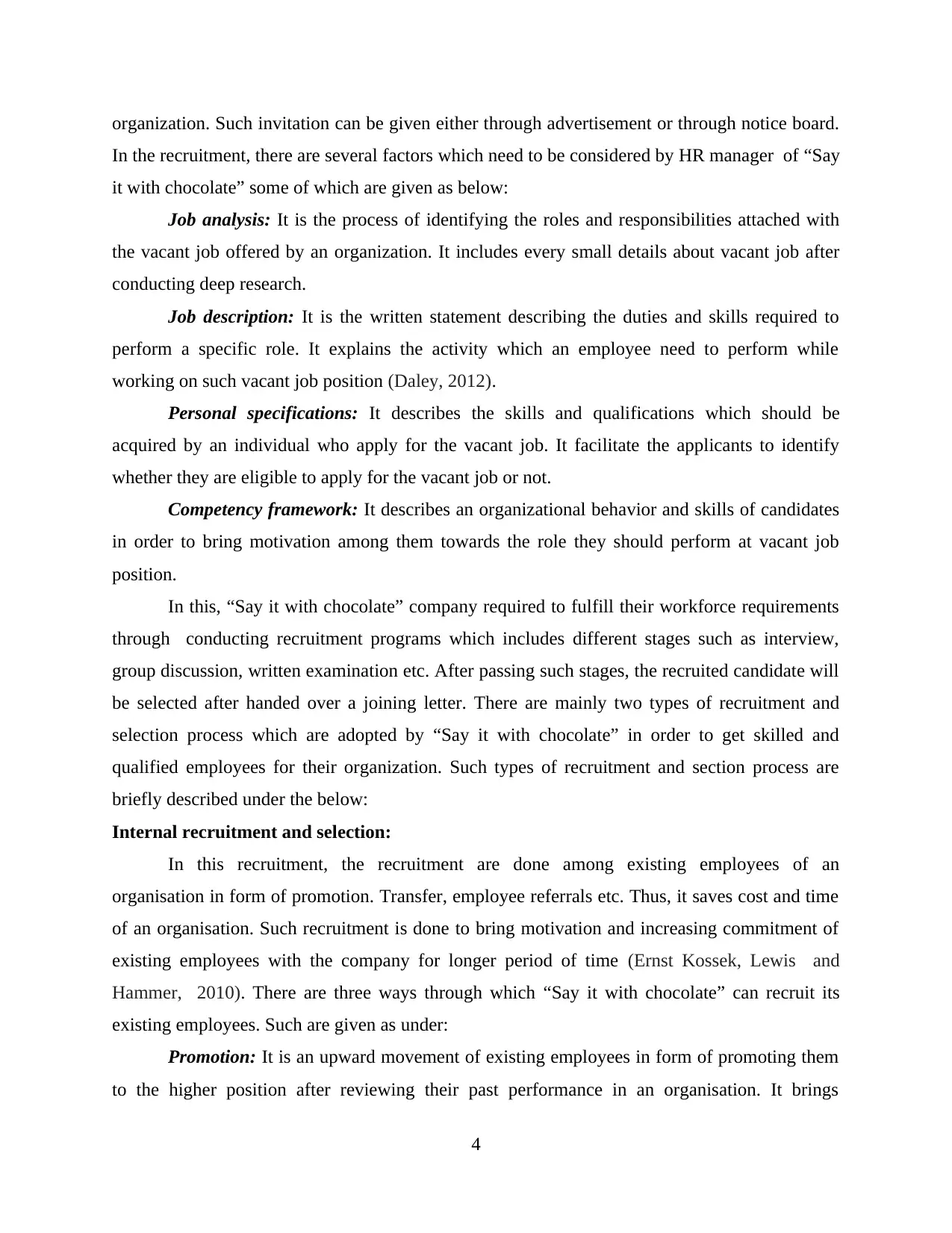
organization. Such invitation can be given either through advertisement or through notice board.
In the recruitment, there are several factors which need to be considered by HR manager of “Say
it with chocolate” some of which are given as below:
Job analysis: It is the process of identifying the roles and responsibilities attached with
the vacant job offered by an organization. It includes every small details about vacant job after
conducting deep research.
Job description: It is the written statement describing the duties and skills required to
perform a specific role. It explains the activity which an employee need to perform while
working on such vacant job position (Daley, 2012).
Personal specifications: It describes the skills and qualifications which should be
acquired by an individual who apply for the vacant job. It facilitate the applicants to identify
whether they are eligible to apply for the vacant job or not.
Competency framework: It describes an organizational behavior and skills of candidates
in order to bring motivation among them towards the role they should perform at vacant job
position.
In this, “Say it with chocolate” company required to fulfill their workforce requirements
through conducting recruitment programs which includes different stages such as interview,
group discussion, written examination etc. After passing such stages, the recruited candidate will
be selected after handed over a joining letter. There are mainly two types of recruitment and
selection process which are adopted by “Say it with chocolate” in order to get skilled and
qualified employees for their organization. Such types of recruitment and section process are
briefly described under the below:
Internal recruitment and selection:
In this recruitment, the recruitment are done among existing employees of an
organisation in form of promotion. Transfer, employee referrals etc. Thus, it saves cost and time
of an organisation. Such recruitment is done to bring motivation and increasing commitment of
existing employees with the company for longer period of time (Ernst Kossek, Lewis and
Hammer, 2010). There are three ways through which “Say it with chocolate” can recruit its
existing employees. Such are given as under:
Promotion: It is an upward movement of existing employees in form of promoting them
to the higher position after reviewing their past performance in an organisation. It brings
4
In the recruitment, there are several factors which need to be considered by HR manager of “Say
it with chocolate” some of which are given as below:
Job analysis: It is the process of identifying the roles and responsibilities attached with
the vacant job offered by an organization. It includes every small details about vacant job after
conducting deep research.
Job description: It is the written statement describing the duties and skills required to
perform a specific role. It explains the activity which an employee need to perform while
working on such vacant job position (Daley, 2012).
Personal specifications: It describes the skills and qualifications which should be
acquired by an individual who apply for the vacant job. It facilitate the applicants to identify
whether they are eligible to apply for the vacant job or not.
Competency framework: It describes an organizational behavior and skills of candidates
in order to bring motivation among them towards the role they should perform at vacant job
position.
In this, “Say it with chocolate” company required to fulfill their workforce requirements
through conducting recruitment programs which includes different stages such as interview,
group discussion, written examination etc. After passing such stages, the recruited candidate will
be selected after handed over a joining letter. There are mainly two types of recruitment and
selection process which are adopted by “Say it with chocolate” in order to get skilled and
qualified employees for their organization. Such types of recruitment and section process are
briefly described under the below:
Internal recruitment and selection:
In this recruitment, the recruitment are done among existing employees of an
organisation in form of promotion. Transfer, employee referrals etc. Thus, it saves cost and time
of an organisation. Such recruitment is done to bring motivation and increasing commitment of
existing employees with the company for longer period of time (Ernst Kossek, Lewis and
Hammer, 2010). There are three ways through which “Say it with chocolate” can recruit its
existing employees. Such are given as under:
Promotion: It is an upward movement of existing employees in form of promoting them
to the higher position after reviewing their past performance in an organisation. It brings
4
Paraphrase This Document
Need a fresh take? Get an instant paraphrase of this document with our AI Paraphraser
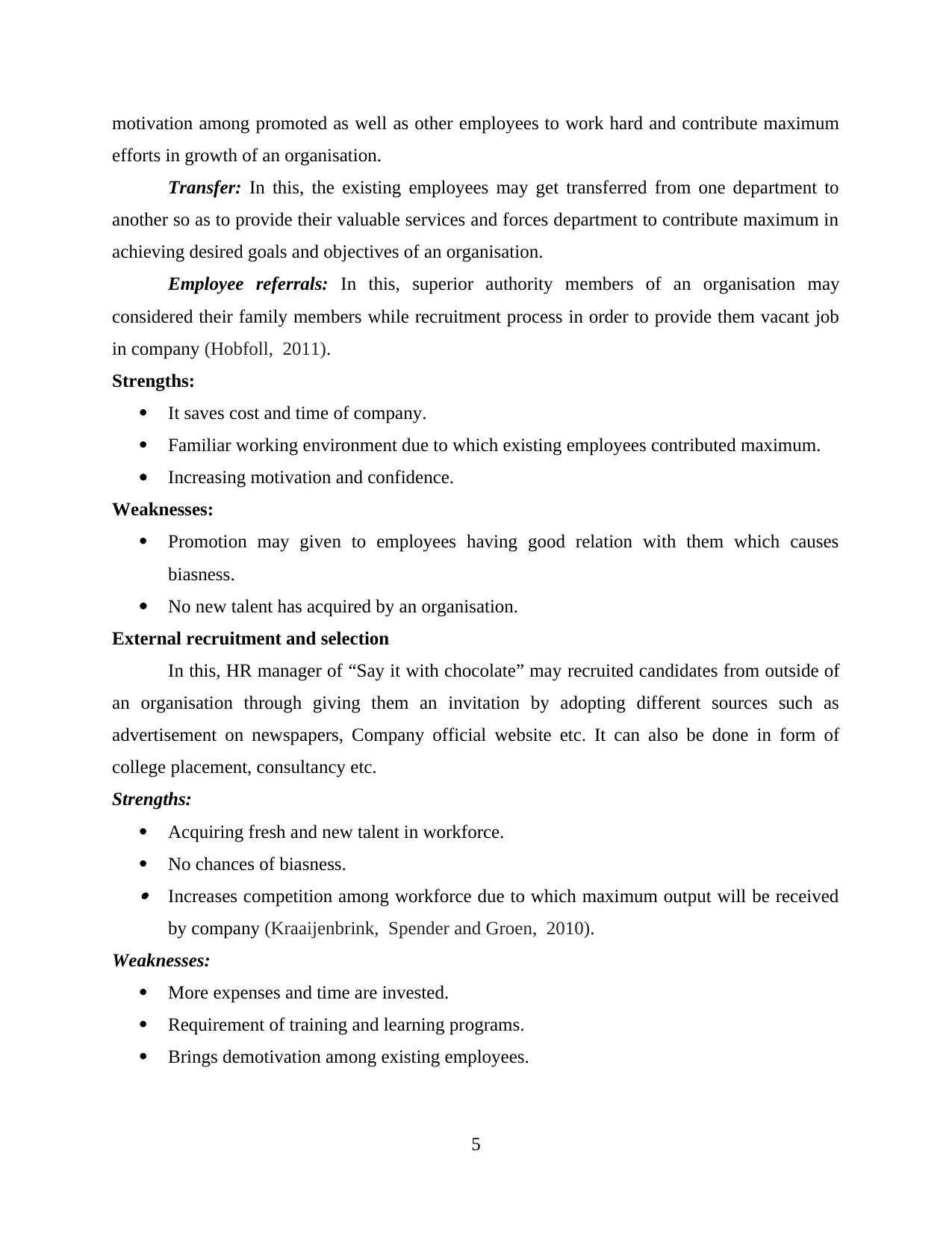
motivation among promoted as well as other employees to work hard and contribute maximum
efforts in growth of an organisation.
Transfer: In this, the existing employees may get transferred from one department to
another so as to provide their valuable services and forces department to contribute maximum in
achieving desired goals and objectives of an organisation.
Employee referrals: In this, superior authority members of an organisation may
considered their family members while recruitment process in order to provide them vacant job
in company (Hobfoll, 2011).
Strengths:
It saves cost and time of company.
Familiar working environment due to which existing employees contributed maximum.
Increasing motivation and confidence.
Weaknesses:
Promotion may given to employees having good relation with them which causes
biasness.
No new talent has acquired by an organisation.
External recruitment and selection
In this, HR manager of “Say it with chocolate” may recruited candidates from outside of
an organisation through giving them an invitation by adopting different sources such as
advertisement on newspapers, Company official website etc. It can also be done in form of
college placement, consultancy etc.
Strengths:
Acquiring fresh and new talent in workforce.
No chances of biasness. Increases competition among workforce due to which maximum output will be received
by company (Kraaijenbrink, Spender and Groen, 2010).
Weaknesses:
More expenses and time are invested.
Requirement of training and learning programs.
Brings demotivation among existing employees.
5
efforts in growth of an organisation.
Transfer: In this, the existing employees may get transferred from one department to
another so as to provide their valuable services and forces department to contribute maximum in
achieving desired goals and objectives of an organisation.
Employee referrals: In this, superior authority members of an organisation may
considered their family members while recruitment process in order to provide them vacant job
in company (Hobfoll, 2011).
Strengths:
It saves cost and time of company.
Familiar working environment due to which existing employees contributed maximum.
Increasing motivation and confidence.
Weaknesses:
Promotion may given to employees having good relation with them which causes
biasness.
No new talent has acquired by an organisation.
External recruitment and selection
In this, HR manager of “Say it with chocolate” may recruited candidates from outside of
an organisation through giving them an invitation by adopting different sources such as
advertisement on newspapers, Company official website etc. It can also be done in form of
college placement, consultancy etc.
Strengths:
Acquiring fresh and new talent in workforce.
No chances of biasness. Increases competition among workforce due to which maximum output will be received
by company (Kraaijenbrink, Spender and Groen, 2010).
Weaknesses:
More expenses and time are invested.
Requirement of training and learning programs.
Brings demotivation among existing employees.
5
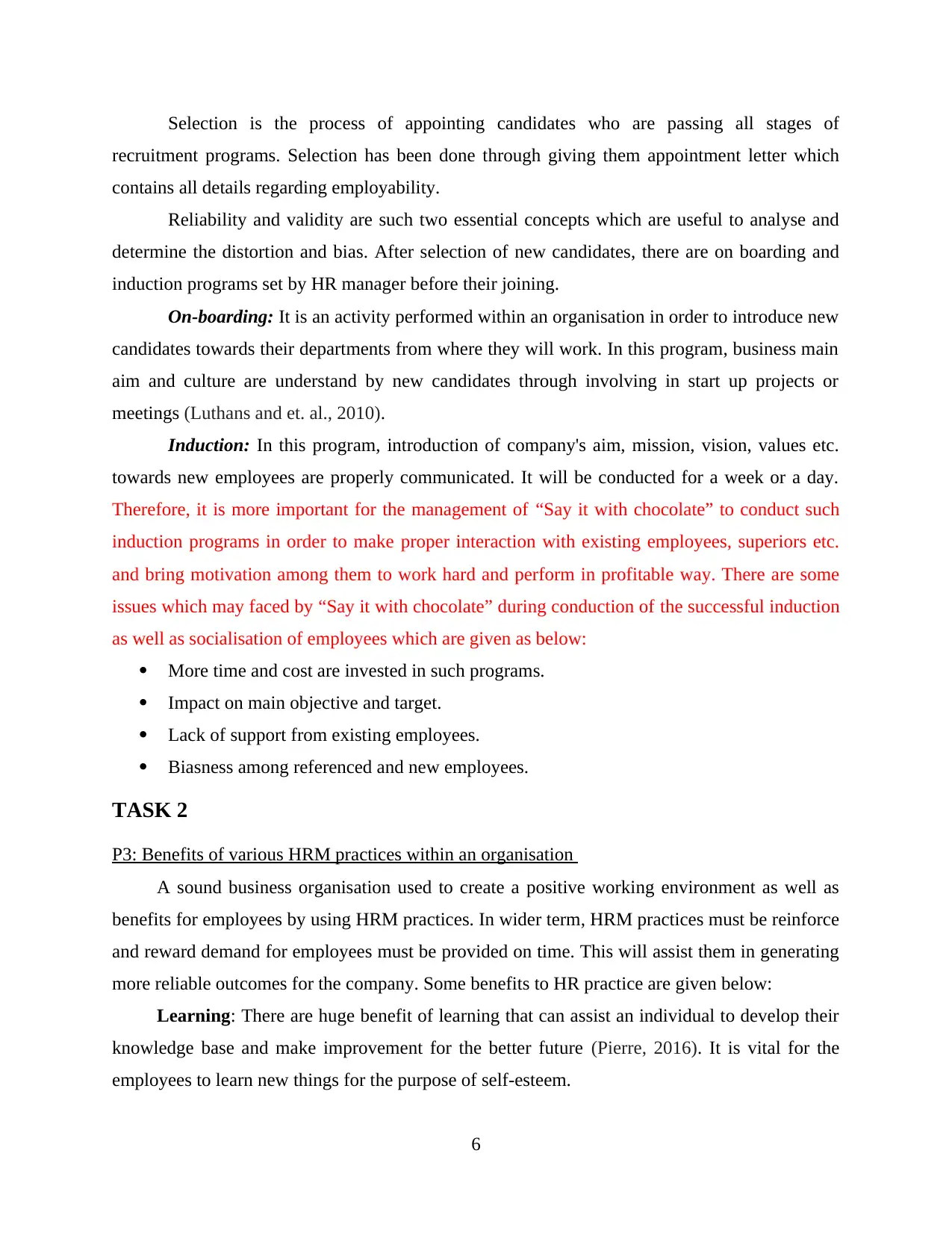
Selection is the process of appointing candidates who are passing all stages of
recruitment programs. Selection has been done through giving them appointment letter which
contains all details regarding employability.
Reliability and validity are such two essential concepts which are useful to analyse and
determine the distortion and bias. After selection of new candidates, there are on boarding and
induction programs set by HR manager before their joining.
On-boarding: It is an activity performed within an organisation in order to introduce new
candidates towards their departments from where they will work. In this program, business main
aim and culture are understand by new candidates through involving in start up projects or
meetings (Luthans and et. al., 2010).
Induction: In this program, introduction of company's aim, mission, vision, values etc.
towards new employees are properly communicated. It will be conducted for a week or a day.
Therefore, it is more important for the management of “Say it with chocolate” to conduct such
induction programs in order to make proper interaction with existing employees, superiors etc.
and bring motivation among them to work hard and perform in profitable way. There are some
issues which may faced by “Say it with chocolate” during conduction of the successful induction
as well as socialisation of employees which are given as below:
More time and cost are invested in such programs.
Impact on main objective and target.
Lack of support from existing employees.
Biasness among referenced and new employees.
TASK 2
P3: Benefits of various HRM practices within an organisation
A sound business organisation used to create a positive working environment as well as
benefits for employees by using HRM practices. In wider term, HRM practices must be reinforce
and reward demand for employees must be provided on time. This will assist them in generating
more reliable outcomes for the company. Some benefits to HR practice are given below:
Learning: There are huge benefit of learning that can assist an individual to develop their
knowledge base and make improvement for the better future (Pierre, 2016). It is vital for the
employees to learn new things for the purpose of self-esteem.
6
recruitment programs. Selection has been done through giving them appointment letter which
contains all details regarding employability.
Reliability and validity are such two essential concepts which are useful to analyse and
determine the distortion and bias. After selection of new candidates, there are on boarding and
induction programs set by HR manager before their joining.
On-boarding: It is an activity performed within an organisation in order to introduce new
candidates towards their departments from where they will work. In this program, business main
aim and culture are understand by new candidates through involving in start up projects or
meetings (Luthans and et. al., 2010).
Induction: In this program, introduction of company's aim, mission, vision, values etc.
towards new employees are properly communicated. It will be conducted for a week or a day.
Therefore, it is more important for the management of “Say it with chocolate” to conduct such
induction programs in order to make proper interaction with existing employees, superiors etc.
and bring motivation among them to work hard and perform in profitable way. There are some
issues which may faced by “Say it with chocolate” during conduction of the successful induction
as well as socialisation of employees which are given as below:
More time and cost are invested in such programs.
Impact on main objective and target.
Lack of support from existing employees.
Biasness among referenced and new employees.
TASK 2
P3: Benefits of various HRM practices within an organisation
A sound business organisation used to create a positive working environment as well as
benefits for employees by using HRM practices. In wider term, HRM practices must be reinforce
and reward demand for employees must be provided on time. This will assist them in generating
more reliable outcomes for the company. Some benefits to HR practice are given below:
Learning: There are huge benefit of learning that can assist an individual to develop their
knowledge base and make improvement for the better future (Pierre, 2016). It is vital for the
employees to learn new things for the purpose of self-esteem.
6
⊘ This is a preview!⊘
Do you want full access?
Subscribe today to unlock all pages.

Trusted by 1+ million students worldwide
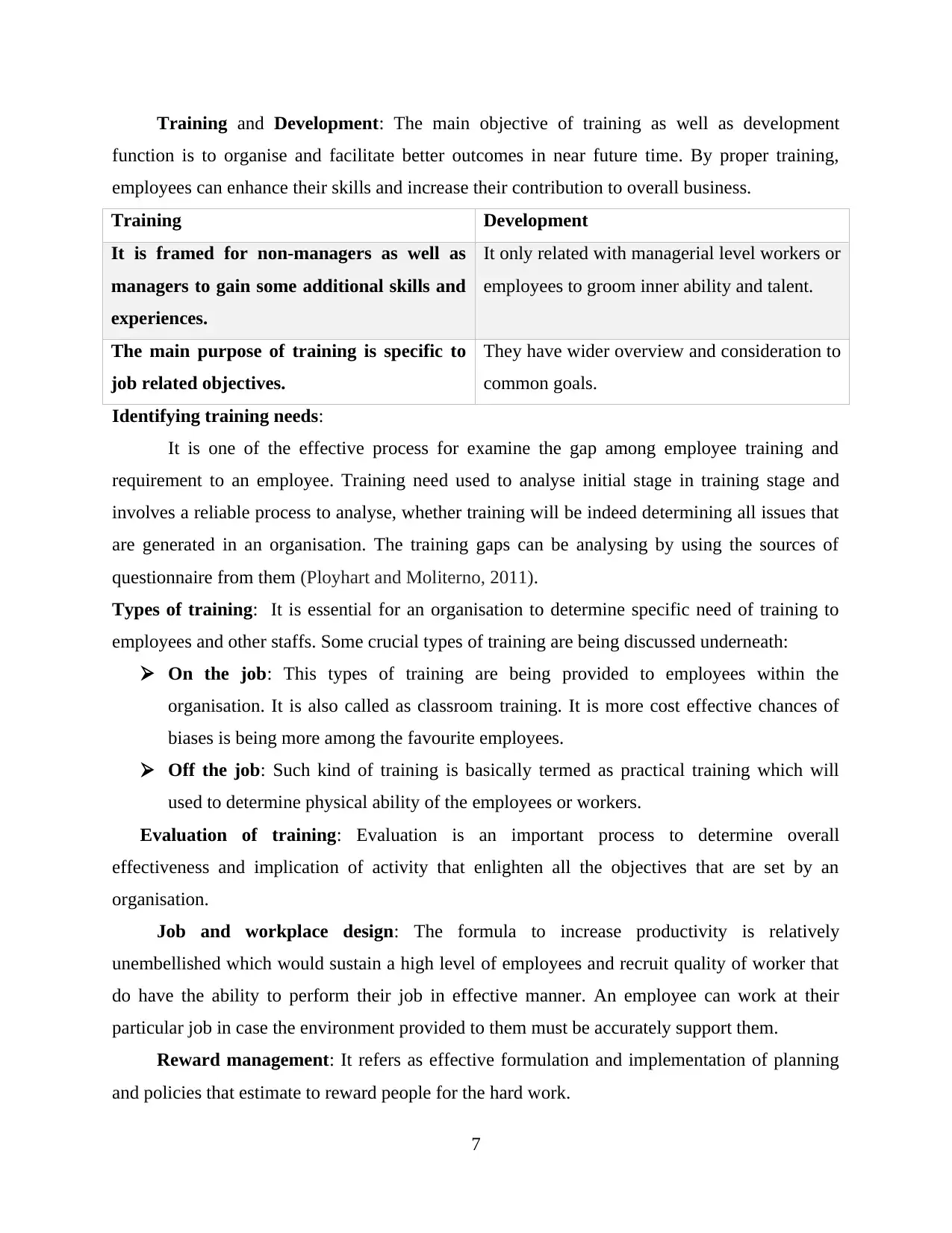
Training and Development: The main objective of training as well as development
function is to organise and facilitate better outcomes in near future time. By proper training,
employees can enhance their skills and increase their contribution to overall business.
Training Development
It is framed for non-managers as well as
managers to gain some additional skills and
experiences.
It only related with managerial level workers or
employees to groom inner ability and talent.
The main purpose of training is specific to
job related objectives.
They have wider overview and consideration to
common goals.
Identifying training needs:
It is one of the effective process for examine the gap among employee training and
requirement to an employee. Training need used to analyse initial stage in training stage and
involves a reliable process to analyse, whether training will be indeed determining all issues that
are generated in an organisation. The training gaps can be analysing by using the sources of
questionnaire from them (Ployhart and Moliterno, 2011).
Types of training: It is essential for an organisation to determine specific need of training to
employees and other staffs. Some crucial types of training are being discussed underneath:
On the job: This types of training are being provided to employees within the
organisation. It is also called as classroom training. It is more cost effective chances of
biases is being more among the favourite employees.
Off the job: Such kind of training is basically termed as practical training which will
used to determine physical ability of the employees or workers.
Evaluation of training: Evaluation is an important process to determine overall
effectiveness and implication of activity that enlighten all the objectives that are set by an
organisation.
Job and workplace design: The formula to increase productivity is relatively
unembellished which would sustain a high level of employees and recruit quality of worker that
do have the ability to perform their job in effective manner. An employee can work at their
particular job in case the environment provided to them must be accurately support them.
Reward management: It refers as effective formulation and implementation of planning
and policies that estimate to reward people for the hard work.
7
function is to organise and facilitate better outcomes in near future time. By proper training,
employees can enhance their skills and increase their contribution to overall business.
Training Development
It is framed for non-managers as well as
managers to gain some additional skills and
experiences.
It only related with managerial level workers or
employees to groom inner ability and talent.
The main purpose of training is specific to
job related objectives.
They have wider overview and consideration to
common goals.
Identifying training needs:
It is one of the effective process for examine the gap among employee training and
requirement to an employee. Training need used to analyse initial stage in training stage and
involves a reliable process to analyse, whether training will be indeed determining all issues that
are generated in an organisation. The training gaps can be analysing by using the sources of
questionnaire from them (Ployhart and Moliterno, 2011).
Types of training: It is essential for an organisation to determine specific need of training to
employees and other staffs. Some crucial types of training are being discussed underneath:
On the job: This types of training are being provided to employees within the
organisation. It is also called as classroom training. It is more cost effective chances of
biases is being more among the favourite employees.
Off the job: Such kind of training is basically termed as practical training which will
used to determine physical ability of the employees or workers.
Evaluation of training: Evaluation is an important process to determine overall
effectiveness and implication of activity that enlighten all the objectives that are set by an
organisation.
Job and workplace design: The formula to increase productivity is relatively
unembellished which would sustain a high level of employees and recruit quality of worker that
do have the ability to perform their job in effective manner. An employee can work at their
particular job in case the environment provided to them must be accurately support them.
Reward management: It refers as effective formulation and implementation of planning
and policies that estimate to reward people for the hard work.
7
Paraphrase This Document
Need a fresh take? Get an instant paraphrase of this document with our AI Paraphraser
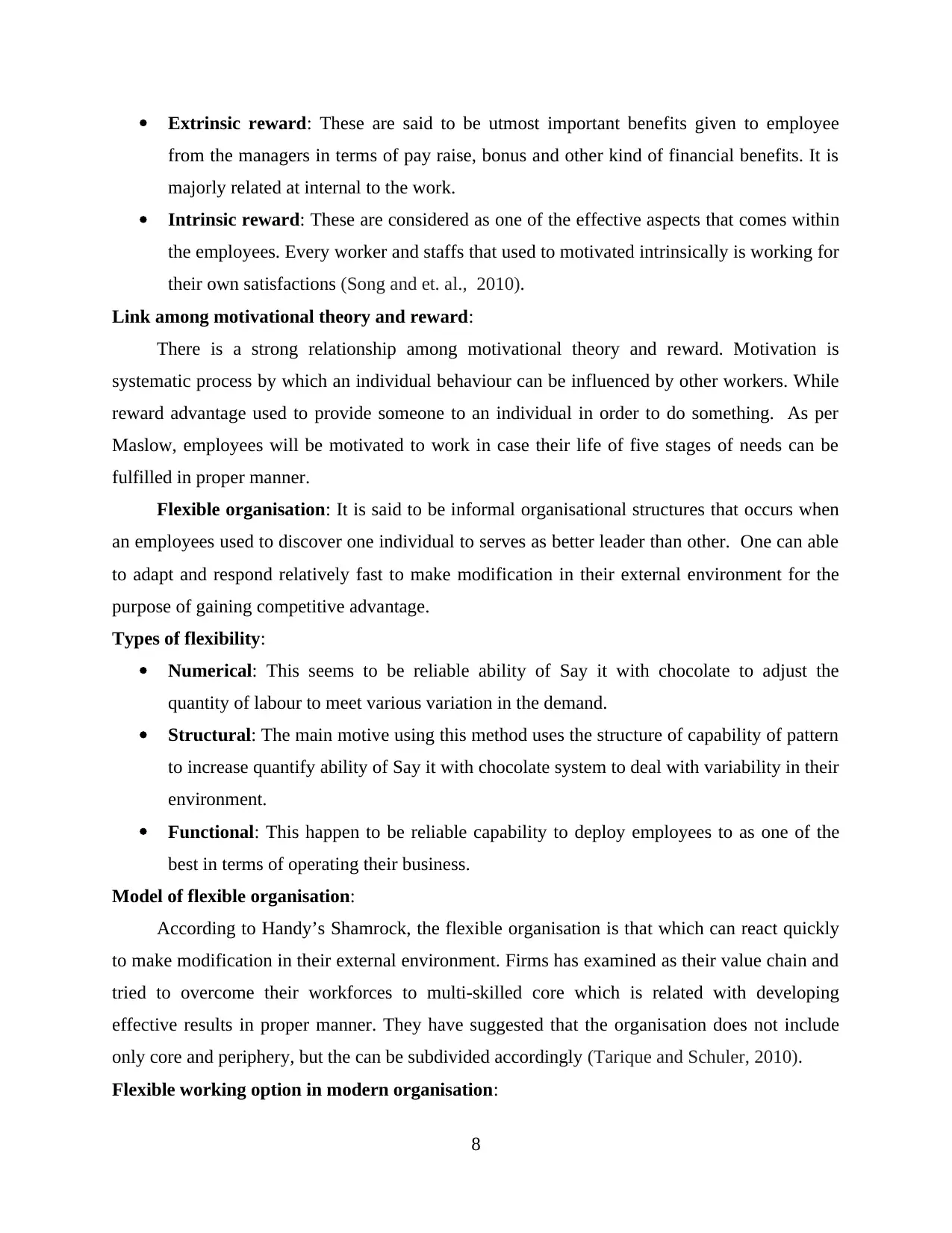
Extrinsic reward: These are said to be utmost important benefits given to employee
from the managers in terms of pay raise, bonus and other kind of financial benefits. It is
majorly related at internal to the work.
Intrinsic reward: These are considered as one of the effective aspects that comes within
the employees. Every worker and staffs that used to motivated intrinsically is working for
their own satisfactions (Song and et. al., 2010).
Link among motivational theory and reward:
There is a strong relationship among motivational theory and reward. Motivation is
systematic process by which an individual behaviour can be influenced by other workers. While
reward advantage used to provide someone to an individual in order to do something. As per
Maslow, employees will be motivated to work in case their life of five stages of needs can be
fulfilled in proper manner.
Flexible organisation: It is said to be informal organisational structures that occurs when
an employees used to discover one individual to serves as better leader than other. One can able
to adapt and respond relatively fast to make modification in their external environment for the
purpose of gaining competitive advantage.
Types of flexibility:
Numerical: This seems to be reliable ability of Say it with chocolate to adjust the
quantity of labour to meet various variation in the demand.
Structural: The main motive using this method uses the structure of capability of pattern
to increase quantify ability of Say it with chocolate system to deal with variability in their
environment.
Functional: This happen to be reliable capability to deploy employees to as one of the
best in terms of operating their business.
Model of flexible organisation:
According to Handy’s Shamrock, the flexible organisation is that which can react quickly
to make modification in their external environment. Firms has examined as their value chain and
tried to overcome their workforces to multi-skilled core which is related with developing
effective results in proper manner. They have suggested that the organisation does not include
only core and periphery, but the can be subdivided accordingly (Tarique and Schuler, 2010).
Flexible working option in modern organisation:
8
from the managers in terms of pay raise, bonus and other kind of financial benefits. It is
majorly related at internal to the work.
Intrinsic reward: These are considered as one of the effective aspects that comes within
the employees. Every worker and staffs that used to motivated intrinsically is working for
their own satisfactions (Song and et. al., 2010).
Link among motivational theory and reward:
There is a strong relationship among motivational theory and reward. Motivation is
systematic process by which an individual behaviour can be influenced by other workers. While
reward advantage used to provide someone to an individual in order to do something. As per
Maslow, employees will be motivated to work in case their life of five stages of needs can be
fulfilled in proper manner.
Flexible organisation: It is said to be informal organisational structures that occurs when
an employees used to discover one individual to serves as better leader than other. One can able
to adapt and respond relatively fast to make modification in their external environment for the
purpose of gaining competitive advantage.
Types of flexibility:
Numerical: This seems to be reliable ability of Say it with chocolate to adjust the
quantity of labour to meet various variation in the demand.
Structural: The main motive using this method uses the structure of capability of pattern
to increase quantify ability of Say it with chocolate system to deal with variability in their
environment.
Functional: This happen to be reliable capability to deploy employees to as one of the
best in terms of operating their business.
Model of flexible organisation:
According to Handy’s Shamrock, the flexible organisation is that which can react quickly
to make modification in their external environment. Firms has examined as their value chain and
tried to overcome their workforces to multi-skilled core which is related with developing
effective results in proper manner. They have suggested that the organisation does not include
only core and periphery, but the can be subdivided accordingly (Tarique and Schuler, 2010).
Flexible working option in modern organisation:
8
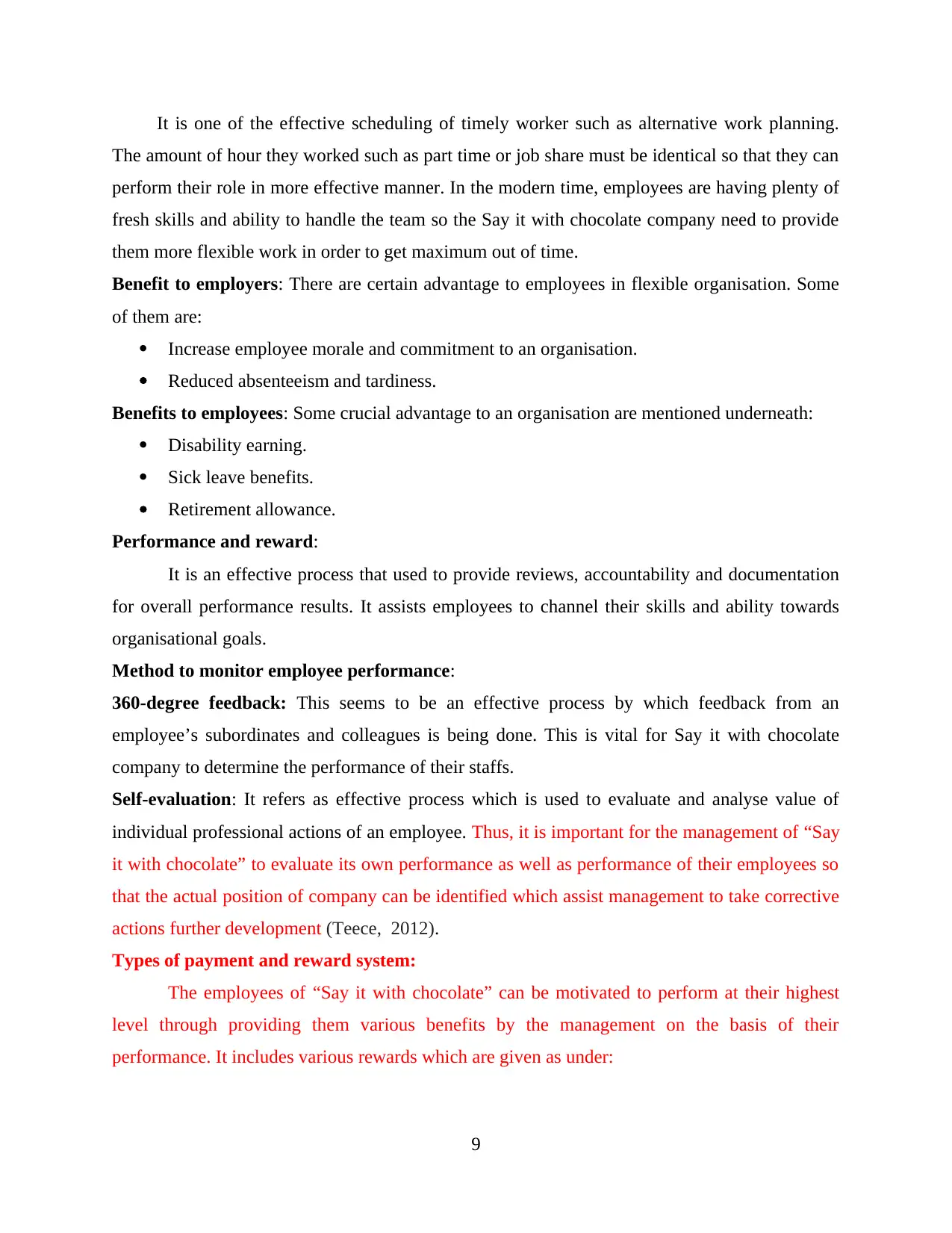
It is one of the effective scheduling of timely worker such as alternative work planning.
The amount of hour they worked such as part time or job share must be identical so that they can
perform their role in more effective manner. In the modern time, employees are having plenty of
fresh skills and ability to handle the team so the Say it with chocolate company need to provide
them more flexible work in order to get maximum out of time.
Benefit to employers: There are certain advantage to employees in flexible organisation. Some
of them are:
Increase employee morale and commitment to an organisation.
Reduced absenteeism and tardiness.
Benefits to employees: Some crucial advantage to an organisation are mentioned underneath:
Disability earning.
Sick leave benefits.
Retirement allowance.
Performance and reward:
It is an effective process that used to provide reviews, accountability and documentation
for overall performance results. It assists employees to channel their skills and ability towards
organisational goals.
Method to monitor employee performance:
360-degree feedback: This seems to be an effective process by which feedback from an
employee’s subordinates and colleagues is being done. This is vital for Say it with chocolate
company to determine the performance of their staffs.
Self-evaluation: It refers as effective process which is used to evaluate and analyse value of
individual professional actions of an employee. Thus, it is important for the management of “Say
it with chocolate” to evaluate its own performance as well as performance of their employees so
that the actual position of company can be identified which assist management to take corrective
actions further development (Teece, 2012).
Types of payment and reward system:
The employees of “Say it with chocolate” can be motivated to perform at their highest
level through providing them various benefits by the management on the basis of their
performance. It includes various rewards which are given as under:
9
The amount of hour they worked such as part time or job share must be identical so that they can
perform their role in more effective manner. In the modern time, employees are having plenty of
fresh skills and ability to handle the team so the Say it with chocolate company need to provide
them more flexible work in order to get maximum out of time.
Benefit to employers: There are certain advantage to employees in flexible organisation. Some
of them are:
Increase employee morale and commitment to an organisation.
Reduced absenteeism and tardiness.
Benefits to employees: Some crucial advantage to an organisation are mentioned underneath:
Disability earning.
Sick leave benefits.
Retirement allowance.
Performance and reward:
It is an effective process that used to provide reviews, accountability and documentation
for overall performance results. It assists employees to channel their skills and ability towards
organisational goals.
Method to monitor employee performance:
360-degree feedback: This seems to be an effective process by which feedback from an
employee’s subordinates and colleagues is being done. This is vital for Say it with chocolate
company to determine the performance of their staffs.
Self-evaluation: It refers as effective process which is used to evaluate and analyse value of
individual professional actions of an employee. Thus, it is important for the management of “Say
it with chocolate” to evaluate its own performance as well as performance of their employees so
that the actual position of company can be identified which assist management to take corrective
actions further development (Teece, 2012).
Types of payment and reward system:
The employees of “Say it with chocolate” can be motivated to perform at their highest
level through providing them various benefits by the management on the basis of their
performance. It includes various rewards which are given as under:
9
⊘ This is a preview!⊘
Do you want full access?
Subscribe today to unlock all pages.

Trusted by 1+ million students worldwide
1 out of 22
Related Documents
Your All-in-One AI-Powered Toolkit for Academic Success.
+13062052269
info@desklib.com
Available 24*7 on WhatsApp / Email
![[object Object]](/_next/static/media/star-bottom.7253800d.svg)
Unlock your academic potential
Copyright © 2020–2025 A2Z Services. All Rights Reserved. Developed and managed by ZUCOL.





